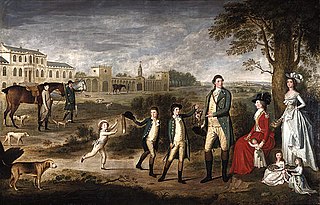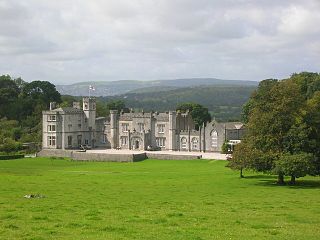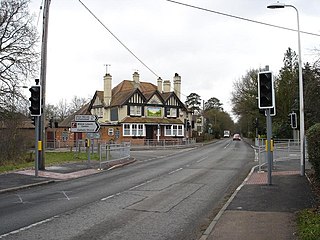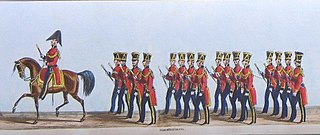
Baron Somers, of Evesham in the County of Worcester, is a title that has been created twice. The title was first created in the Peerage of England in 1697 for Sir John Somers, so that he could sit in the House of Lords and serve as Lord Chancellor. The title became extinct on Lord Somers' death in 1716. His sister and co-heiress, Mary Somers, married Charles Cocks, a member of a prominent Worcestershire family. Their grandson Charles Cocks represented Reigate in Parliament from 1747 to 1784, and was created a baronet, of Dumbleton in the County of Gloucester, in the Baronetage of Great Britain in 1772. In 1784 the barony held by his great-uncle was revived when he was made Baron Somers, of Evesham in the County of Worcester, in the Peerage of Great Britain.
Baron Macdonald, of Slate in the County of Antrim, is a title in the Peerage of Ireland. It was created in 1776 for Sir Alexander Macdonald, 9th Baronet, of Sleat. The Macdonald family of Sleat descends from Uisdean Macdonald, also known as Hugh of Sleat, or Hugh Macdonald, who was an illegitimate son of Alexander Macdonald, Earl of Ross. On 28 May 1625, his great-great-great-great-grandson Donald Gorm Og Macdonald was created a baronet, of Sleat in the Isle of Skye in the County of Inverness, in the Baronetage of Nova Scotia. The baronetcy was created with remainder to heirs male whatsoever and with a special clause of precedence which provided that it should have precedency over all former baronets.

There have been seven baronetcies created for members of the Lowther family, one in the Baronetage of Nova Scotia, two in the Baronetage of England, two in the Baronetage of Great Britain and two in the Baronetage of the United Kingdom. Two of the creations are extant as of 2008.

There have been ten baronetcies created for persons with the surname Browne, six in the Baronetage of Great Britain, three in the Baronetage of Ireland and one in the Baronetage of Nova Scotia. Only one creation is extant as of 2010. Three of the creations were for members of the Browne family headed by the Viscount Montagu.
There have been three Agnew baronetcies. The first was created in the Baronetage of Nova Scotia. The second and third were created in the Baronetage of the United Kingdom.

There have been five baronetcies created for person with the surname Erskine, two in the Baronetage of Nova Scotia, one in the Baronetage of Great Britain and two in the Baronetage of the United Kingdom. Two of the creations are extant as of 2010.

There have been five baronetcies created for persons with the surname Baird, three in the Baronetage of Nova Scotia and two in the Baronetage of the United Kingdom. Three of the creations are extant as of 2010. The Baird Baronets of Newbyth and of Sauchtonhall are all descended from Andrew Baird who acquired lands at Auchmedden, Aberdeenshire, in 1539. The main line, Baird of Auchmedden expired on the death in 1777 of Sir William Baird whose Auchmedden estate was forfeit and sold following his involvement in the Jacobite Rising of 1745.
There have been four baronetcies created for members of the Astley family, three in the Baronetage of England and one in the Baronetage of the United Kingdom. Only one creation is extant as of 2008. The Astley family were descended from Sir Thomas de Astley of Astley, Warwickshire, who was killed in the Battle of Evesham in 1265. He married twice. From his first marriage to Joane de Blois descended the Astley baronets of Patshull, whose family seat was at Patshull Hall, Staffordshire, and the Astley baronets of Everley, Wiltshire. From his second marriage to Editha Constable of Melton Constable, Norfolk, descended the Astley baronets of Melton Constable, the Astley baronets of Hillmorton, and the Barons Astley of Reading.

There have been six baronetcies created for persons with the surname Middleton, four in the Baronetage of England, one in the Baronetage of Great Britain and one in the Baronetage of the United Kingdom. One creation is extant as of 2008.
There have been two baronetcies created for people with the surname Tollemache, or Talmash, one in the Baronetage of England and one in the Baronetage of Great Britain.
There have been two baronetcies created for persons with the surname Proby, one in the Baronetage of England and one in the Baronetage of the United Kingdom. The first creation is extinct while the second creation is extant.
There have been three baronetcies created for persons with the surname Bellingham, one in the Baronetage of England, one in the Baronetage of Ireland and one in the Baronetage of Great Britain. As of 2014 one creation is extant.
There have been three baronetcies created for persons with the surname Lindsay, one in the Baronetage of Nova Scotia and two in the Baronetage of the United Kingdom. One creation is extant.
There have been five baronetcies created for persons with the surname Hill, one in the Baronetage of Nova Scotia, one in the Baronetage of Great Britain, one in the Baronetage of Ireland and two in the Baronetage of the United Kingdom. Three of the creations are extant as of 2008.
There have been eight baronetcies created for persons with the surname Graham, two in the Baronetage of Nova Scotia, two in the Baronetage of England, one in the Baronetage of Great Britain and three in the Baronetage of the United Kingdom.
The Campbell, later Cockburn-Campbell Baronetcy, of Gartsford in the County of Ross, is a title in the Baronetage of the United Kingdom. It was created on 3 July 1821 for Lieutenant-General Alexander Campbell, with remainder, in default of male issue of his own, to 1) the male issue of his daughter Olympia, failing which 2) to the male issue of his daughter Isabella Charlotte. He had already been created a baronet on 6 May 1815, with normal remainder to heirs male. Campbell had earlier fought at the Battle of Seringapatam in 1799 and commanded a division during the Peninsular War. The creation of 1815 became extinct on his death in 1824 while he was succeeded in the 1821 creation by Alexander Thomas Cockburn, who assumed the additional surname of Campbell the same year. The fourth Baronet was President of the Legislative Council of Western Australia. The sixth Baronet was the author of the autobiography "Land of Lots of Time".
There have been two baronetcies created for persons with the surname Coghill, both in the Baronetage of Great Britain. One creation is extant as of 2008.
There have been two baronetcies created for persons with the surname of Pye. Both are extinct.

There have been two Buller Baronetcies.














